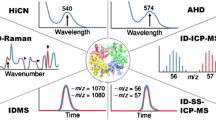Abstract
Triple isotope dilution mass spectrometry (triple IDMS) has been applied for the first time on protein quantification, especially on transferrin. Transferrin as an acute phase protein is a marker for several inflammation processes in the human body. Therefore, in Germany, the accurate and precise measurement of this important analyte is required. In this work, a new approach to triple IDMS is described and compared to double IDMS. Also, complete uncertainty budgets for both methods were set up to demonstrate the ability of this method to be used as a reference procedure. The relative expanded uncertainty (k = 2) for triple IDMS (3.6 %) is smaller than the one for double IDMS (4.0 %). The content of transferrin found in the human serum reference material ERM-DA470k/IFCC ((2.41 ± 0.08) g/kg) with both methods was in good agreement with each other and with the certificate. For triple IDMS ((2.426 ± 0.086) g/kg) and for double IDMS ((2.317 ± 0.092) g/kg), transferrin was determined. Although triple IDMS is a little more time consuming compared to double IDMS, there is the advantage that the isotopic composition of the spike material does not have to be determined. This is very useful especially in case of a marginal isotopic enrichment in the spike or problems with the accurate measurement of the spike isotope ratio.

Using triple instead of double species-specific IDMS helps to reduce the uncertainty and improves the reliability of the results, especially in cases where an accurate determination of the spike isotope ratio is difficult or impossible, because the spike ratio cancels from the equation






Similar content being viewed by others
References
Bundesärztekammer (2010) Richtlinie der Bundesärztekammer zur Qualitätssicherung labormedizinischer Untersuchungen (Guideline for the quality assurance of laboratory medical investigations). Deutsches Ärzteblatt, 12
de Gruyter (ed) (2007) Pschyrembel, klinisches Wörterbuch (clinical dictionary), 261st edn. Walther de Gruyter, Berlin
Aubailly L, Ducbert AS, Danzé PM, Forzy G (2011) Clin Biochem 44:731–735
Helander A, Fors M, Zarkrisson B (2001) Alcohol Alcohol 36(5):406–412
Wu L, Wu J, Zhang J, Zhou Y, Ren GH (2008) J Chromatogr B 867(1):63–68
Referenzlabor für Bioanalytik (bioanalytical reference laboratory), interlaboratory comparison: IG 1/12 http://www.dgkl-rfb.de. Accessed 21 May 2012
Sargent M, Harrington C, Harte R (eds) (2002) Guidelines for achieving high accuracy in isotope dilution mass spectrometry (IDMS). Royal Society of Chemistry, Cambridge
Heumann, K (1988) In: Adams, R; van Grieken, R (eds) Inorganic mass spectrometry. Wiley, New York
Rienitz O, Pramann A, Schiel D (2010) Int J Mass Spectrom 289:47–53
Rottmann L, Heumann K (1994) Fresenius J Anal Chem 350:221–227
Heumann K, Rottmann L, Vogl J (1998) Spectrochim Acta B: Atom Spectrosc 53:273–287
Swart C, Rienitz O, Schiel D (2011) Talanta 83:1544–1551
Meija J, Mester Z (2008) Anal Chim Acta 607(2):115–125
Vogl J (2012) Rapid Commun Mass Spectrom 26(3):275–281
Milton MJT, Wang J (2002) Int J Mass Spectrom 218:63–73
del Castillo Busto M, Montes-Bayón M, Sans-Medel A (2006) Anal Chem 78(24):8218–8226
Watters RL Jr, Eberhardt KR, Beary ES, Fassett JD (1997) Metrologia 34:87–96
IRMM, Certificate of analysis ERM-DA470k/IFCC, accepted as ERM, Geel, July 2008
Bureau International des Poids et Mesures (2008) Evaluation of measurement data—guide to expression of uncertainty in measurement. JCGM 100
Vogl, J (2005) In: Nelms, SM (ed) Inductively coupled plasma mass spectrometry handbook. Blackwell, Oxford
Author information
Authors and Affiliations
Corresponding author
Additional information
Published in the topical collection Metallomics with guest editors Uwe Karst and Michael Sperling.
Rights and permissions
About this article
Cite this article
Frank, C., Rienitz, O., Swart, C. et al. Improving species-specific IDMS: the advantages of triple IDMS. Anal Bioanal Chem 405, 1913–1919 (2013). https://doi.org/10.1007/s00216-012-6315-x
Received:
Revised:
Accepted:
Published:
Issue Date:
DOI: https://doi.org/10.1007/s00216-012-6315-x




